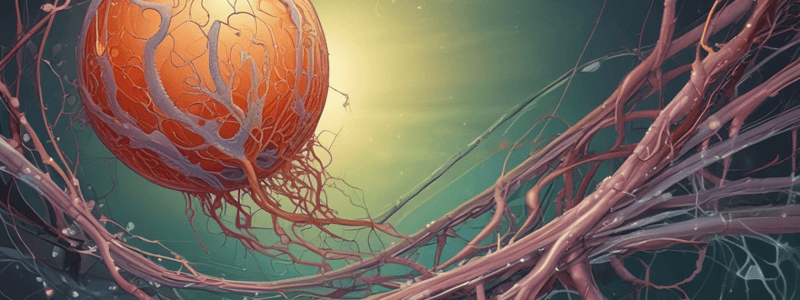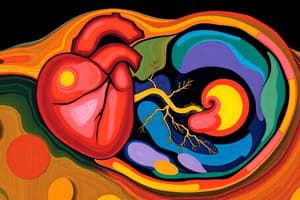Podcast
Questions and Answers
What is the significance of the blastocyst's inner cell mass division during embryonic development?
What is the significance of the blastocyst's inner cell mass division during embryonic development?
The inner cell mass divides to form the epiblast and hypoblast, which will eventually give rise to the embryo's tissues and the yolk sac, respectively.
What are the two primary stages of embryonic development that occur between 15-23 days, and what are their respective outcomes?
What are the two primary stages of embryonic development that occur between 15-23 days, and what are their respective outcomes?
Gastrulation (occurs between 15-20 days) and Neurulation (occurs between 20-23 days), resulting in the formation of the three primary germ layers and the establishment of the neural tube, respectively.
What is the outcome of gastrulation in terms of germ layer formation?
What is the outcome of gastrulation in terms of germ layer formation?
Gastrulation results in the formation of the three primary germ layers: ectoderm, mesoderm, and endoderm.
What is the significance of the embryonic axis establishment during gastrulation?
What is the significance of the embryonic axis establishment during gastrulation?
What is the relationship between the epiblast and hypoblast during embryonic development?
What is the relationship between the epiblast and hypoblast during embryonic development?
What is the timing of heart development relative to gastrulation and neurulation?
What is the timing of heart development relative to gastrulation and neurulation?
What is the primary function of the notochord during neurulation, and how does it achieve this function?
What is the primary function of the notochord during neurulation, and how does it achieve this function?
What are the three primary germ layers formed during gastrulation, and what are some examples of tissues or organs that arise from each layer?
What are the three primary germ layers formed during gastrulation, and what are some examples of tissues or organs that arise from each layer?
What is the significance of the primitive streak in the formation of the three germ layers during gastrulation?
What is the significance of the primitive streak in the formation of the three germ layers during gastrulation?
What is the timing of gastrulation, and what are the key events that occur during this process?
What is the timing of gastrulation, and what are the key events that occur during this process?
What is the role of the notochord in the establishment of the embryonic axis, and how does it relate to the formation of the neural tube?
What is the role of the notochord in the establishment of the embryonic axis, and how does it relate to the formation of the neural tube?
What is the relationship between the onset of neurulation and the completion of gastrulation, and what are the key events that occur during neurulation?
What is the relationship between the onset of neurulation and the completion of gastrulation, and what are the key events that occur during neurulation?
During which process does neurulation occur?
During which process does neurulation occur?
What is the function of the notochord in neurulation?
What is the function of the notochord in neurulation?
What is the name of the structure that forms from the neural plate?
What is the name of the structure that forms from the neural plate?
What are the lateral portions of the neural plate called?
What are the lateral portions of the neural plate called?
What is the name of the stage of neurulation where the neural tube separates from the overlying ectoderm?
What is the name of the stage of neurulation where the neural tube separates from the overlying ectoderm?
What is the term for the process by which the embryo develops its central nervous system?
What is the term for the process by which the embryo develops its central nervous system?
What is the significance of the blastulation stage in embryonic development, and how does it relate to the formation of the embryoblast and hypoblast?
What is the significance of the blastulation stage in embryonic development, and how does it relate to the formation of the embryoblast and hypoblast?
Describe the process of gastrulation, including the movement of cells and the formation of the three primary germ layers.
Describe the process of gastrulation, including the movement of cells and the formation of the three primary germ layers.
What is the role of the neural plate in neurulation, and how does it contribute to the formation of the neural tube?
What is the role of the neural plate in neurulation, and how does it contribute to the formation of the neural tube?
What is the significance of the optically transparent structure that forms during week 5-6 of embryonic development, and how does it relate to eye development?
What is the significance of the optically transparent structure that forms during week 5-6 of embryonic development, and how does it relate to eye development?
Describe the process of eye development during weeks 3-10, including the formation of the optic cup and the lens vesicle.
Describe the process of eye development during weeks 3-10, including the formation of the optic cup and the lens vesicle.
What is the significance of the choroid fissure in eye development, and how does it relate to the formation of the optic cup?
What is the significance of the choroid fissure in eye development, and how does it relate to the formation of the optic cup?
Flashcards are hidden until you start studying
Study Notes
Embryonic Development
- Fertilization begins development, followed by cell division and cleavage
- Morula stage: 124 cells, compacted into a ball
- Blastula stage: 816 cells, with a blastocoel cavity
- Blastulation: formation of the blastula, with an outer trophectoderm and an inner cell mass
Gastrulation
- Formation of the three primary germ layers: ectoderm, mesoderm, and endoderm
- Epiblast cells migrate through the primitive streak, forming the three germ layers
- Ectoderm: outer layer, gives rise to CNS, epidermis, and melanocytes
- Mesoderm: middle layer, gives rise to heart, muscle, and kidney cells
- Endoderm: inner layer, gives rise to lung, thyroid, and pancreatic cells
Neurulation
- Begins with the formation of the notochord, a flexible rod derived from mesoderm
- Notochord induces the formation of the central nervous system (CNS) by signaling to the ectoderm layer above it
- Neurulation gets underway while gastrulation is still occurring
- Formation of the neural plate, neural groove, and neural tube
- Neural crest cells separate from the neural tube and migrate into the periphery
Eye Development
- Week 3-4: formation of the optic vesicle
- Week 5-6: formation of the optic cup, lens vesicle, and choroid fissure
- Week 7-8: formation of the cornea, anterior chamber, and pupil
- Week 8: eyelids form
- Week 9: formation of the iris and ciliary body
Studying That Suits You
Use AI to generate personalized quizzes and flashcards to suit your learning preferences.




